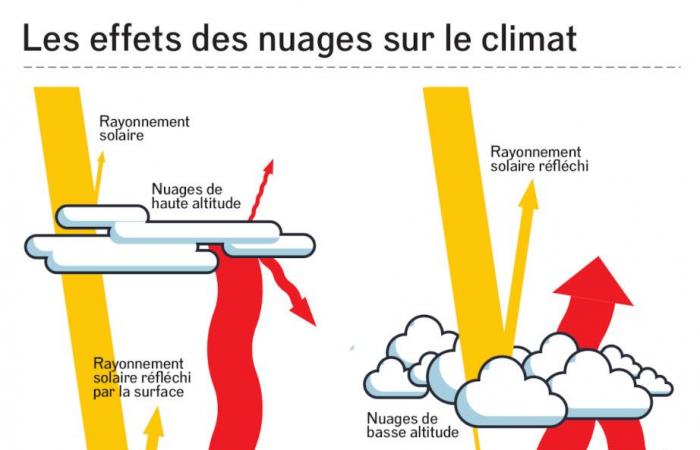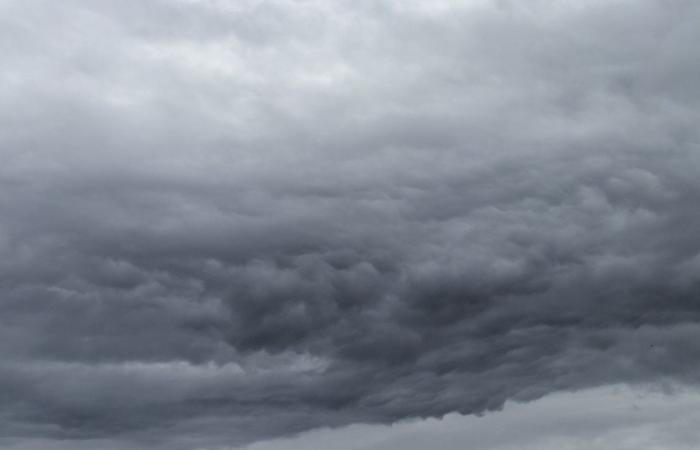It is described as “ the most complex research mission » of the European Space Agency (ESA) nowadays. Launched into orbit on May 29, the EarthCARE satellite of theESA, designed in collaboration with the Japanese space agency, features four cutting-edge instruments. For at least three years, they will be aimed at the Earth’s atmosphere in order to examine one of the most important and mysterious players in the climate: the clouds.
“ Several satellites have already studied clouds in the past, but, for the first time, thanks to the combination of our instruments, we will measure all their physical characteristics at the same time. This is what interests researchersexplains Dominique Gillieron, head of Earth observation projects atESA, they need to improve their modeling and test their current models. »
Because clouds play an absolutely crucial role in the Earth’s climate system. They cover roughly two-thirds of the globe, creating a “ parasol effect » giant: by reflecting part of the solar radiation towards space, they protect us from their energy and cool the climate. If all the clouds disappeared, the Earth could be 5°C warmer, according to the World Climate Research Program.
If the Earth did not have clouds, the temperature of the globe would already be several degrees higher. But their action is not only cooling.
© P-OC/ Reporterre
The figure is old and should be taken with a grain of salt as understanding the physics of clouds is difficult. But it gives an order of magnitude of the decisive influence of the latter on global temperature. To be more precise, researchers estimate the energy we receive from the sun by calculating the power of radiation received, in watts, for each square meter of earth’s surface (noted W/m2). The clouds thus cool the Earth by around 20 W/m2. Compare to 4.5 W/m2which will be the (already enormous) surplus stored because of greenhouse gases between now and 2100, in the median warming scenario of 3°C.
Climatic uncertainties
The cooling role of clouds is therefore crucial. Problem: they themselves are disrupted by climate change. The warmer the climate, the less clouds cool it. Researchers now know with a high degree of certainty, according to the latest IPCC report, that this feedback loop amplifies human-caused warming.
How much will the clouds make the situation worse? ? This remains one of the main sources of climate uncertainty for scientists. He is “ likely » that the overall effect of clouds adds 0.12 W/m2 at 0.72 W/m2 for each degree of warming, according to the IPCC, but certain phenomena benefit from a low degree of confidence. “ The diversity of clouds, their size, their optical thickness, their altitude… all this contributes to generating uncertainty »explains Étienne Vignon, research manager CNRS at the Dynamic Meteorology Laboratory.
“ The diversity of clouds, their size, their optical thickness, their altitude… all this contributes to generating uncertainty », explains Étienne Vignon, research manager in dynamic meteorology at CNRS.
© P-OC/ Reporterre
To understand the challenges facing climate scientists, we need to immerse our heads in the clouds for a moment. The atmosphere permanently contains water in the form of gas, in varying proportions. But its capacity to contain it is limited: when it reaches saturation, the excess water condenses, changing into small liquid droplets, or even ice crystals, particularly depending on the pressure and temperature conditions. These droplets and crystals form clouds.
Parasol effect versus greenhouse effect
Simple ? Except that these clouds don’t just have a parasol effect. They also contribute to the greenhouse effect, that is, to warming the Earth by absorbing and emitting infrared radiation (see the graph below). Cooling parasol effect on one side, warming greenhouse effect on the other, which of the two effects dominates ? It depends on the clouds.
They can in particular contain a variable proportion of liquid droplets and ice crystals, which has an important influence at temperate latitudes because the droplets have a greater reflective power. The size of the droplets and the shape of the crystals also play a role.

© Stéphane Jungers / Reporterre
In cumulus clouds, warm and low clouds at a maximum altitude of 2 or 3 km, often very thick, the cooling parasol effect dominates. Conversely, cirrus clouds, which float much higher in the troposphere, up to 14 km, are very thin, block the sun’s rays much less and the greenhouse effect is dominant there, their climatic influence is therefore warming. .
Climate feedback loops
Climate change is disrupting these balances in all directions. Rising temperatures will cause cirrus clouds to rise in altitude, which will reinforce their warming characteristics. Other processes may have opposite effects. “ With warming, we expect to have less ice and an increasing proportion of droplets in clouds in mid-latitude regions, therefore an increase in the parasol effect and a cooling effect »underlines Étienne Vignon.
Conversely, the researcher is also working on modeling clouds in the Arctic Ocean and, there, the feedback loop could make warming worse. “ In the fall, the sea ice becomes increasingly smaller, leading to more evaporation from the ocean and therefore more cloud formation at low altitudes. These cause a lot of greenhouse effect », he said. As there is little sun in this region in the fall, the parasol effect does not play much role. The greenhouse effect, on the contrary, accelerates the melting of the sea ice, further accelerating warming in a deleterious feedback loop.

Greenhouse effect from below, parasol effect from above… Although insufficiently known, the influence of clouds on the climate will nevertheless be decisive.
© P-OC/ Reporterre
These two contradictory effects remain poorly understood and difficult to quantify. Above all, they represent only a small part of the climatic interactions involving clouds. To this should be added the overall evolution of cloud cover (at each degree of warming, the atmosphere can contain 7 % more water), the distribution of the clouds (the parasol effect covers more surface area with very scattered clouds than if they are very concentrated), the speed at which these clouds change into rain and disappear, the difficulty to anticipate the presence of these clouds during the day or at night (in the absence of sun, the parasol effect is absent and the greenhouse effect dominates at night), etc.
“ In Antarctica, the parasol effect does not play a role since the white icy surface already reflects the sun very well. But if the ice melts and reveals darker ground, the parasol effect of the clouds becomes much more important.explains Christoph Kittel, climatology researcher at Grenoble Alpes University. Depending on the share of ice and liquid water in the cloud, the consequences also change completely. Depending on which cloud model one uses, the future of global melting in Antarctica varies from 50 % in the worst scenario. Tipping points are possible but still very poorly understood. »
Modeling challenges
This is the other difficulty that researchers encounter: beyond the complexity of clouds, there is that of modeling them in their computers. “ Our models work very well and we have good indications on the average evolution of the climate. But there remain strong disparities between models, in particular on the numerous uncertainties linked to clouds and there remains a lot of scientific work to be done on the parameterization »notes Étienne Vignon.
Hence the interest in continuing and refining observations, as the EarthCARE satellite does. In addition to being interested in the physics of clouds and their thermal radiation, the instruments of theESA will focus on the “ cloud precursors ». Because if water condenses when the atmosphere is saturated, cloud formation is favored by the presence of dust, sea salt, fossil fuels, pollen or other particles around which droplets and crystals will agglomerate.

In addition to the type of cloud, the natural or artificial external elements that compose them will also influence their effects.
© P-OC/ Reporterre
However, the presence of these aerosols in the air is itself disrupted by climate change and adds a layer of complexity to understanding climate change. “ The evolution of storms in the Sahara can, for example, raise more sand, the evolution of vegetation or early flowering linked to warming can change the distribution of pollen, more frequent marine storms bring salts into the atmosphere, without talk about industrial pollutants and fossil fuels »lists Dominique Gilliéron.
“ Will these changes in aerosols promote the formation of cirrus clouds which increase the greenhouse effect or cumulus clouds with a cooling effect? ? » he questions. The models may have refined their response in three or four years, when the satellite has completed its mission. Until then, there remains one certainty that climatologists tirelessly harp on: the more greenhouse gases we emit, the more we sink into the mists of catastrophic disruption.











